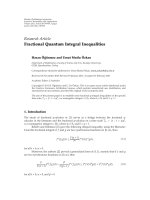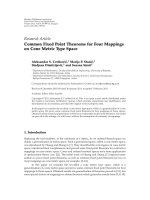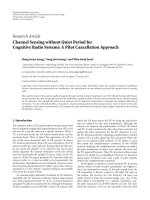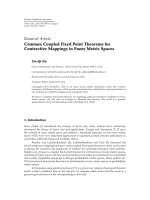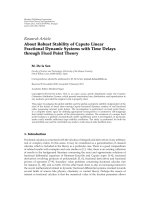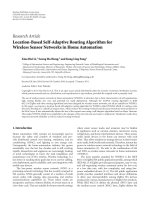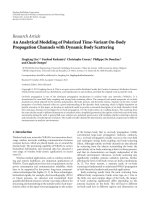Báo cáo hóa học: " Research Article Common Fixed Points of Weakly Contractive and Strongly Expansive Mappings in Topological Spaces" ppt
Bạn đang xem bản rút gọn của tài liệu. Xem và tải ngay bản đầy đủ của tài liệu tại đây (516.67 KB, 15 trang )
Hindawi Publishing Corporation
Journal of Inequalities and Applications
Volume 2010, Article ID 746045, 15 pages
doi:10.1155/2010/746045
Research Article
Common Fixed Points of Weakly Contractive and
Strongly Expansive Mappings in Topological Spaces
M. H. Shah,
1
N. Hussain,
2
andA.R.Khan
3
1
Department of Mathematical Sciences, LUMS, DHA Lahore, Pakistan
2
Department of Mathematics, King Abdulaziz University, P.O. Box 80203, Jeddah 21589, Saudi Arabia
3
Department of Mathematics and Statistics, King Fahd University of Petroleum and Minerals, Dhahran
31261, Saudi Arabia
Correspondence should be addressed to A. R. Khan,
Received 17 May 2010; Accepted 21 July 2010
Academic Editor: Yeol J. E. Cho
Copyright q 2010 M. H. Shah et al. This is an open access article distributed under the Creative
Commons Attribution License, which permits unrestricted use, distribution, and reproduction in
any medium, provided the original work is properly cited.
Using the notion of weakly F-contractive mappings, we prove several new common fixed point
theorems for commuting as well as noncommuting mappings on a topological space X. By analogy,
we obtain a common fixed point theorem of mappings which are strongly F-expansive on X.
1. Introduction
It is well known that if X is a compact metric space and f : X → X is a weakly contractive
mapping see Section 2 for the definition, then f has a fixed point in X see 1,p.17.In
late sixties, Furi and Vignoli 2 extended this result to α-condensing mappings acting on a
bounded complete metric space see 3 for the definition. A generalized version of Furi-
Vignoli’s theorem using the notion of weakly F-contractive mappings acting on a topological
space was proved in 4see also 5.
On the other hand, in 6 while examining KKM maps, the authors introduced
a new concept of lower upper semicontinuous function see Definition 2.1, Section 2
which is more general than the classical one. In 7, the authors used this definition of
lower semicontinuity to redefine weakly F-contractive mappings and strongly F-expansive
mappings see Definition 2.6, Section 2 to formulate and prove several results for fixed
points.
In this article, we have used the notions of weakly F-contractive mappings f : X →
X where X is a topological space
to prove a version of the above-mentioned fixed point
theorem 7, Theorem 1 for common fixed points see Theorem 3.1. We also prove a common
2 Journal of Inequalities and Applications
fixed point theorem under the assumption that certain iteration of the mappings in question
is weakly F-contractive. As a corollary to this fact, we get an extension to common fixed
points of 7, Theorem 3 for Banach spaces with a quasimodulus endowed with a suitable
transitive binary relation. The most interesting result of this section is Theorem 3.8 wherein
the strongly F-expansive condition on f with some other conditions implies that f and g
have a unique common fixed point.
In Section 4, we define a new class of noncommuting self-maps and prove some
common fixed point results for this new class of mappings.
2. Preliminaries
Definition 2.1 see 6.LetX be a topological space. A function f : X → R is said to be lower
semi-continuous from above lsca at x
0
if for any net x
λ
λ∈Λ
convergent to x
0
with
f
x
λ
1
≤ f
x
λ
2
for λ
2
≤ λ
1
, 2.1
we have
f
x
0
≤ lim
λ∈Λ
f
x
λ
. 2.2
A function f : X → R is said to be lsca if it is lsca at every x ∈ X.
Example 2.2. i Let X R. Define f : X → R by
f
x
⎧
⎪
⎪
⎪
⎪
⎨
⎪
⎪
⎪
⎪
⎩
x 1, when x>0,
1
2
, when x 0,
−x 1, when x<0.
2.3
Let z
n
n≥1
be a sequence of nonnegative terms such that z
n
n≥1
converges to 0. Then
f
z
n1
≤ f
z
n
for λ
2
n ≤ n 1 λ
1
,f
0
1
2
< 1 lim
n →∞
f
z
n
. 2.4
Similarly, if z
n
n≥1
is a sequence in X of negative terms such that z
n
n≥1
converges to 0, then
f
z
n1
≤ f
z
n
for λ
2
n ≤ n 1 λ
1
,f
0
1
2
< 1 lim
n →∞
f
z
n
. 2.5
Thus, f is lsca at 0.
Journal of Inequalities and Applications 3
ii Every lower semi-continuous function is lsca but not conversely. One can check
that the function f : X → R with X R defined below is lsca at 0 but is not lower semi-
continuous at 0:
f
x
⎧
⎨
⎩
x 1, when x ≥ 0,
x, when x<0.
2.6
The following lemmas state some properties of lsca mappings. The first one is an analogue
of Weierstrass boundedness theorem and the second one is about the composition of a
continuous function and a function lsca.
Lemma 2.3 see 6. Let X be a compact topological space and f : X → R a function lsca. Then
there exists x
0
∈ X such that fx
0
inf{fx : x ∈ X}.
Lemma 2.4 see 7. Let X be a topological space and f : X → Y a continuous function. If g :
X → R is a function lsca, then the composition function h g ◦ f : X → R is also lsca.
Proof. Fix x
0
∈ X × X and consider a net x
λ
λ∈Λ
in X convergent to x
0
such that
h
x
λ
1
≤ h
x
λ
2
for λ
2
≤ λ
1
. 2.7
Set z
λ
fx
λ
and z fx
0
. Then since f is continuous, lim
λ
fx
λ
fx
0
∈ X, and g lsca
implies that
g
z
g
f
x
0
≤ lim
λ
g
f
x
λ
lim
λ
g
z
λ
2.8
with gz
λ
1
≤ gz
λ
2
for λ
2
≤ λ
1
. Thus hx
0
≤ lim
λ
hx
λ
and h is lsca.
Remark 2.5 see 6.LetX be topological space. Let f : X → X be a continuous function and
F : X × X → R lsca. Then g : X → R defined by gxFx, fx is also lsca. For this, let
x
λ
λ∈Λ
be a net in X convergent to x ∈ X. Since f is continuous, lim
λ
fx
λ
fx. Suppose
that
g
x
λ
1
≤ g
x
λ
2
for λ
2
≤ λ
1
. 2.9
Then since F is lsca, we have
g
x
F
x, f
x
≤ lim
λ
F
x
λ
,f
x
λ
lim
λ
g
x
λ
. 2.10
Definition 2.6 see 7.LetX be a topological space and F : X × X → R be lsca. The mapping
f : X → X is said to be
i weakly F-contractive if Ffx,fy <Fx, y for all x, y, ∈ X such that x
/
y,
ii strongly F-expansive if Ffx,fy >Fx, y for all x, y ∈ X such that x
/
y.
4 Journal of Inequalities and Applications
If X is a metric space with metric d and F d, then we call f, respectively, weakly contractive
and strongly expansive.
Let f, g : X → X. The set of fixed points of f resp., g is denoted by Ffresp.,
Fg.Apointx ∈ M is a coincidence point common fixed point of f and g if fx gx
x fx gx. The set of coincidence points of f and g is denoted by Cf, g. Maps f, g :
X → X are called 1 commuting if fgx gfx for all x ∈ X, 2 weakly compatible 8 if
they commute at their coincidence points, that is, if fgx gfx whenever fx
gx,and3
occasionally weakly compatible 9 if fgx gfx for some x ∈ Cf, g.
3. Common Fixed Point Theorems for Commuting Maps
In this section we extend some results in 7 to the setting of two mappings having a unique
common fixed point.
Theorem 3.1. Let X be a topological space, x
0
∈ X, and f, g : X → X self-mappings such that for
every countable set U ⊆ X,
U f
U
∪
g
x
0
⇒ U is relatively compact 3.1
and f, g commute on X. If
i f is continuous and weakly F-contractive or
ii g is continuous and weakly F-contractive with gU ⊆ U,
then f and g have a unique common fixed point.
Proof. Let x
1
gx
0
and define the sequence x
n
n≥1
by setting x
n1
fx
n
for n ≥ 1. Let
A {x
n
: n ≥ 1}. Then
A f
A
∪
g
x
0
, 3.2
so by hypothesis
A is compact. D efine ϕ : A −→ R, by
ϕ
x
⎧
⎨
⎩
F
x, f
x
if f is continuous,
F
x, g
x
if g is continuous.
3.3
Now if f or g is continuous and since F is lsca, then by Remark 2.5, ϕ is lsca. So by Lemma 2.3,
ϕ has a minimum at, say, a ∈
A.
i Suppose that f is continuous and weakly F-contractive. Then ϕxFx, fx as f is
continuous. Now observe that if a ∈
A, f is continuous, and fA ⊆ A, then fa ∈ A. We
show that faa. Suppose that fa
/
a; then
ϕ
f
a
F
f
a
,f
f
a
<F
a, f
a
ϕ
a
, 3.4
Journal of Inequalities and Applications 5
a contradiction to the minimality of ϕ at a. Having faa, one can see that gaa. Indeed,
if ga
/
a then we have
F
a, g
a
F
f
a
,gf
a
F
f
a
,fg
a
<F
a, g
a
3.5
a contradiction.
ii Suppose that g is continuous and weakly F-contractive with gU ⊆ U. Then ϕx
Fx, gx as g is continuous. Put U
A; then a ∈ A, g is continuous, and gA ⊆ A implies
that ga ∈
A. We claim that gaa, for otherwise we will have
ϕ
g
a
F
g
a
,g
g
a
<F
a, g
a
ϕ
a
3.6
which is a contradiction. Hence the claim follows.
Now suppose that fa
/
a then we have
F
a, f
a
F
g
a
,fg
a
F
g
a
,gf
a
<F
a, f
a
, 3.7
a contradiction, hence fa
a.
In both cases, uniqueness f ollows from the contractive conditions: suppose there exists
b ∈
A such that fbb gb. Then we have
F
a, b
F
f
a
,f
b
<F
a, b
,
F
a, b
F
g
a
,g
b
<F
a, b
3.8
which is false. Thus f and g have a unique common fixed point.
If g id
X
, then Theorem 3.1i reduces to 7, Theorem 1.
Corollary 3.2 see 7, Theorem 1. Let X be a topological space, x
0
∈ X, and f : X → X
continuous and weakly F-contractive. If the implication U ⊆ X,
U f
U
∪
{
x
0
}
⇒ U is relatively compact, 3.9
holds for every countable set U ⊆ X, then f has a unique fixed point.
Example 3.3. Let c
0
, ·
∞
be the Banach space of all null real sequences. Define
X
x x
n
n≥1
∈ c
0
: x
n
∈
0, 1
, for n ≥ 1
. 3.10
Let k ∈ N and p
n
n≥1
⊆ 0, 1 a sequence such that
p
n
n≤k
⊆
{
0
}
,
p
n
n>k
⊆
0, 1
3.11
6 Journal of Inequalities and Applications
with p
n
→ 1asn →∞. Define the mappings f, g : X → X by
f
x
f
n
x
n
n≥1
,g
x
g
n
x
n
n≥1
, 3.12
where x ∈ X, x
n
∈ 0, 1 and f
n
,g
n
: 0, 1 → 0, 1 are such that for 1 ≤ n ≤ k,
f
n
x
n
− f
n
y
n
x
n
− y
n
2
, 3.13
g
n
x
n
− g
n
y
n
x
n
− y
n
3
, 3.14
and for n>k
f
n
x
n
p
n
x
n
2
,g
n
x
n
p
n
x
n
3
. 3.15
We verify the hypothesis of Theorem 3.1.
i Observe that f and g are, clearly, continuous by their definition.
ii For x, y ∈ X, we have
f
x
− f
y
sup
n≥1
f
n
x
n
− f
n
y
n
,
g
x
− g
y
sup
n≥1
g
n
x
n
− g
n
y
n
.
3.16
Since the sequences f
n
x
n
n≥1
and g
n
x
n
n≥1
are null sequences, there exists N ∈ N such
that
sup
n≥1
f
n
x
n
− f
n
y
n
f
N
x
N
− f
N
y
N
,
sup
n≥1
g
n
x
n
− g
n
y
n
g
N
x
N
− g
N
y
N
.
3.17
Hence
f
n
x
n
− f
n
y
n
f
N
x
N
− f
N
y
N
<
x
N
− y
N
sup
n≥1
x
n
− y
n
x
n
− y
n
,
g
n
x
n
− g
n
y
n
g
N
x
N
− g
N
y
N
<
x
N
− y
N
sup
n≥1
x
n
− y
n
x
n
− y
n
.
3.18
This implies that f and g are weakly contractive. Thus f and g are continuous and weakly
contractive. Next suppose that for any countable set U ⊆ X, we have
U f
U
∪
g
0
c
0
, 3.19
Journal of Inequalities and Applications 7
then by the definition of f, we can consider U ⊆ 0, 1. Hence closure of U being closed subset
of a compact set is compact. Also
fg
x
p
n
2
2
x
n
n≥N
gf
x
for every x ∈ U. 3.20
So by Theorem 3.1, f and g have a unique common fixed point.
Corollary 3.4. Let (X, d be a metric space, x
0
∈ X, and f, g : X → X self-mappings such that for
every countable set U ⊆ X,
U f
U
∪
g
x
0
⇒U is relatively compact, 3.21
and f, g commute on X. If
i f is continuous and weakly contractive or
ii g is continuous and weakly contractive with gU ⊆ U,
then f and g have a unique common fixed point.
Proof. It is immediate from Theorem 3.1 with F d.
Corollary 3.5. Let X be a compact metric space, x
0
∈ X, and f, g : X → X self-mappings such that
for every countable set U ⊆ X,
U f
U
∪
g
x
0
⇒ U is closed 3.22
and f, g commute on X. If
i f is continuous and weakly contractive or
ii g is continuous and weakly F-contractive with gU ⊆ U,
then f and g have a unique common fixed point.
Proof. It is immediate from Theorem 3.1.
Theorem 3.6. Let X be a topological space, x
0
∈ X, and f, g : X → X self-mappings such that for
every countable set U ⊆ X,
(1) U fU ∪{gx
0
} ⇒ U is relatively compact;
(2) U f
k
U ∪{gx
0
} ⇒ U is relatively compact for some k ∈ N;
(3) U f
k
U ∪{g
k
x
0
} ⇒ U is relatively compact for some k ∈ N.
And f, g commute on X. Further, if
i
f is continuous and f
k
weakly F-contractive or
ii
g is continuous and g
k
weakly F-contractive with g
U
⊆ U,
3.23
then f and g have a unique common fixed point.
8 Journal of Inequalities and Applications
Proof. Part 3: we proceed as in Theorem 3.1.Letx
1
g
k
x
0
for some k ∈ N and define the
sequence x
n
n≥1
by setting x
n1
f
k
x
n
for n ≥ 1. Let A {x
n
: n ≥ 1}. Then
A f
k
A
∪
g
k
x
0
, 3.24
so by hypothesis 3,
A is compact. Define ϕ : A → R by
ϕ
x
⎧
⎨
⎩
F
x, f
k
x
if f is continuous,
F
x, g
k
x
if g is continuous.
3.25
Now since F is lsca and if f or g is continuous, then by Remark 2.5 ϕ would be lsca and hence
by Lemma 2.3, ϕ would have a minimum, say, at a ∈
A.
i Suppose that f is continuous and f
k
weakly F-contractive. Then ϕxFx, f
k
x as f
is continuous. Now observe that a ∈
A, f is continuous, and fA ⊆ A implies that
f
k
is continuous and f
k
A ⊆ A and so f
k
a ∈ A for some k ∈ N. We show that
f
k
aa. Suppose that f
k
a
/
a for any k ∈ N, then
ϕ
f
k
a
F
f
k
a
,f
k
f
k
a
<F
a, f
k
a
ϕ
a
, 3.26
a contradiction to the minimality of ϕ at a. Therefore, f
k
aa, for some k ∈ N. One can
check that gaa. Suppose that g
k
a
/
a, then we have
F
a, g
k
a
F
f
k
a
,g
k
f
k
a
F
f
k
a
,f
k
g
k
a
<F
a, g
k
a
3.27
a contradiction. Thus a is a common fixed point of f
k
and g
k
and hence of f and g.
ii Suppose that g is continuous and g
k
weakly F-contractive with gU ⊆ U. Then ϕx
Fx, g
k
x as g is continuous. Put U A. Then a ∈ A, g continuous and gA ⊆ A imply
that g
k
a ∈ A. We claim that g
k
aa, for otherwise we will have
ϕ
g
k
a
F
g
k
a
,g
k
g
k
a
<F
a, g
k
a
ϕ
a
3.28
which is a contradiction. Hence the claim follows.
Now suppose that f
k
a
/
a then we have
F
a, f
k
a
F
g
k
a
,f
k
g
k
a
F
g
k
a
,g
k
f
k
a
<F
a, f
k
a
3.29
Journal of Inequalities and Applications 9
a contradiction, hence f
k
aa. Thus a is a common fixed point of f
k
and g
k
and hence of f
and g.
Now we establish the uniqueness of a. Suppose there exists b ∈
A such that f
k
b
b g
k
b for some k ∈ N.Nowiff is continuous and f
k
is weakly F-contractive, then we
have
F
a, b
F
f
k
a
,f
k
b
<F
a, b
3.30
and if g is continuous and g
k
is weakly F-contractive, then we have
F
a, b
F
g
k
a
,g
k
b
<F
a, b
3.31
which is false. Thus f
k
and g
k
have a unique common fixed point which obviously is a unique
common fixed point of f and g.
Part 2. The conclusion follows if we set h g
k
in part 3.
Part 1. The conclusion follows if we set S f
k
and T g
k
in part 3.
AniceconsequenceofTheorem 3.6 is the following theorem where X is taken as a
Banach space equipped with a transitive binary relation.
Theorem 3.7. Let X X, · be a Banach space with a transitive binary relation such that
x≤y for x, y ∈ X with x y. Suppose, further, that the mappings A, m : X → X are such
that the following conditions are satisfied:
i 0 mx and mx x for all x ∈ X;
ii 0 x y, then Ax Ay;
iii A is bounded linear operator and A
k
x < x for some k ∈ N and for all x ∈ X such that
x
/
0 with 0 x.
If either
a
m
f
x
− f
y
Am
g
x
− g
y
and g is contractive,
b
m
g
x
− g
y
Am
f
x
− f
y
and f is contractive,
3.32
for all x, y ∈ X with f, g commuting on X and if one of the conditions, (1)–(3), of Theorem 3.6 holds,
then f and
g have a unique common fixed point.
Proof. a Suppose that mfx−fy Amgx−gy for all x, y ∈ X with f, g commuting
on X and g is contractive. Then we have
0 m
f
x
− f
y
Am
g
x
− g
y
.
3.33
10 Journal of Inequalities and Applications
Next
0 m
f
2
x
− f
2
y
Am
gf
x
− gf
y
Am
fg
x
− fg
y
A
2
m
g
x
− g
y
.
3.34
Therefore, after k-steps, k ∈ N,weget
0 m
f
k
x
− f
k
y
A
k
m
g
x
− g
y
.
3.35
Hence,
f
k
x
− f
k
y
m
f
k
x
− f
k
y
≤
A
k
m
g
x
− g
y
<
m
g
x
− g
y
g
x
− g
y
≤
x − y
.
3.36
So f
k
is weakly contractive. Since f is continuous as A is bounded and g contractive by
Theorem 3.6, f and g have a unique common fixed point.
b Suppose that mgx−gy Amfx−fy and f is contractive for all x, y ∈ X
with f, g commuting on X and f being contractive. The proof now follows if we mutually
interchange f, g in a above.
Theorem 3.8. Let X be a topological space, Y ⊂ Z ⊂ X with Y closed and x
0
∈ Y. Let f, g : Y → Z
be mappings such that for every countable set U ⊆ Y,
f
U
U ∪
g
x
0
⇒ U is relatively compact 3.37
and f, g commute on X. If f is a homeomorphism and strongly F-expansive, then f and g have a
unique common fixed point.
Proof. Suppose that f is a homeomorphism and strongly F-expansive. Let z, w ∈ Z with
z
/
w. Then there exists x, y ∈ Y such that z fx and w fy or f
−1
zx and f
−1
w
y. Since f is strongly F-expansive, we have
F
z, w
F
f
x
,f
y
>F
x, y
F
f
−1
z
,f
−1
w
, 3.38
Journal of Inequalities and Applications 11
or
F
f
−1
z
,f
−1
w
<F
z, w
. 3.39
So f
−1
is a weakly F-contractive mapping. Choose any countable subset V of Z and set B
V ∩ Y. Suppose that
B f
−1
B
∪
g
x
0
. 3.40
Then f
−1
BU for some U ⊆ Y and we get
f
U
U ∪
g
x
0
. 3.41
So by hypothesis
U is compact and since f is a homeomorphism, fUB is compact. Since
fgxgfx for every x ∈
U and f
−1
BU, we have
f
−1
g
x
f
−1
g
ff
−1
x
f
−1
gf
f
−1
x
f
−1
fg
f
−1
x
gf
−1
x
3.42
for every x ∈
B. Thus
B f
−1
B
∪
g
x
0
⇒ B is relatively compact 3.43
and f
−1
gxgf
−1
x for every x ∈ B. Since f
−1
is continuous and weakly F-contractive, by
Theorem 3.1, the mappings f
−1
and g have a unique common fixed point, say, a ∈ B. Since
f
−1
aa implies that a fa, so a is a unique common fixed point of f and g.
The following example illustrates Theorem 3.8.
Example 3.9. Let X R
2
with the River metric d : X × X → R
defined by
d
x, y
⎧
⎨
⎩
δ
x, y
if x, y are collinear,
δ
x, 0
δ
0,y
, otherwise,
3.44
where x x
1
,y
1
, y x
2
,y
2
,andδ denotes the Euclidean metric on X. Then X is a
topological space with a topology induced by the metric d. Consider the sets Y, Z defined
by
Y
u, v
∈ R
2
: u v ∈
0, 1
,
Z
u, v
∈ R
2
: u v ∈
0,
3
2
.
3.45
12 Journal of Inequalities and Applications
Let the mappings f,g : Y → Z be defined by fu, v3/2u, 3/2v and gu, v
2/3u, 2/3v for u, v ∈ Y. Then f is clearly a homeomorphism and for an arbitrary
countable subset A of Y and x
0
0, 0 ∈ Y ,
f
A
A ∪
g
x
0
. 3.46
If and only if A {0, 0}. Indeed, if u, v ∈ A such that u, v
/
0, 0, then
f
A
3
2
A
/
A ∪
{
0, 0
}
A ∪
g
x
0
. 3.47
Further, fgu, vgfu, v for every u, v ∈ Y. Set Fu, vρu, v where ρ : X × X → R
is the Radial metric defined by
ρ
x, y
⎧
⎨
⎩
y
1
− y
2
if x
1
x
2
,
y
1
y
2
|
x
1
− x
2
|
if x
1
/
x
2
,
3.48
and x x
1
,y
1
; y x
2
,y
2
. Now for x, y ∈ Y, since
F
f
x
,f
y
ρ
f
x
,f
y
3
2
ρ
x, y
>ρ
x, y
F
x, y
, 3.49
f is strongly F-expansive. Also F ρ : X, d × X, d → R
is lower semi-continuous and
hence lsca. Thus all the conditions of Theorem 3.8 are satisfied and f and g have a unique
common fixed point.
4. Occasionally Banach Operator Pair and Weak F-Contractions
In this section, we define a new class of noncommuting self-maps and prove some common
fixed point results for this new class of maps.
The pair T, I is called a Banach operator pair 10 if the set FI is T-invariant, namely,
TFI ⊆ FI. Obviously, commuting pair T, I is a Banach operator pair but converse is
not true, in general; see 10–13.IfT, I is a Banach operator pair, then I,T need not be a
Banach operator pair.
Definition 4.1. The pair T, I is called occasionally Banach operator pair if
d
u, Tu
≤ diam F
I
for some u ∈ F
I
. 4.1
Clearly, Banach operator pair BOPT, I is occasionally Banach operator pair OBOP but
not conversely, in general.
Example 4.2. Let X R M with usual norm. Define I, T : M
→ M by Ix x
2
and
Tx 2−x
2
,forx
/
−1andI−1T−11/2. FI{0, 1} and CI,T{−1, 1}. Obviously
T, I is OBOP but not BOP as T0 2
/
∈ FI. Further, T,I is not weakly compatible and hence
not commuting.
Journal of Inequalities and Applications 13
Example 4.3. Let X R with usual norm and M 0, 1. Define T, I : M → M by
Tx
⎧
⎪
⎪
⎪
⎪
⎪
⎪
⎪
⎪
⎨
⎪
⎪
⎪
⎪
⎪
⎪
⎪
⎪
⎩
1
2
, if x ∈
0,
1
4
,
1 − 2x, if x ∈
1
4
,
1
2
,
0, if x ∈
1
2
, 1
,
4.2
Ix
⎧
⎪
⎪
⎪
⎨
⎪
⎪
⎪
⎩
2x, if x ∈
0,
1
2
,
1, if x ∈
1
2
, 1
.
4.3
Here FI{0, 1} and T01/2
/
∈ FI implies that T, I is not Banach operator pair.
Similarly, I, T is not Banach operator pair. Further,
|
0 − T
0
|
0 −
1
2
1
2
≤ 1 diam
F
I
4.4
imply that T, I is OBOP. Further, note that CT, I{1/4} and TI1/4
/
IT1/4. Hence
{T, I} is not occasionally weakly compatible pair.
Definition 4.4. Let X be a nonempty set and d : X × X → 0, ∞ be a mapping such that
d
x, y
0 if and only if x y. 4.5
For a space X, d satisfying 4.5 and A ⊆ X, the diameter of A is defined by
diam
A
sup
d
x, y
: x, y ∈ A
. 4.6
Here we extend this concept to the space X, d satisfying condition 4.5.
Definition 4.5. Let X, d be a space satisfying 4.5.ThepairT, I is called occasionally Banach
operator pair on X iff there is a point u in X such that u ∈ FI and
d
u, Tu
≤ diam
F
I
,d
Tu,u
≤ diam
F
I
. 4.7
Theorem 4.6. Let X be a topological space, x
0
∈ X, and f, g : X → X self-mappings such that for
every countable set U ⊆ X,
U f
U
∪
{
x
0
}
⇒ U is relatively compact. 4.8
14 Journal of Inequalities and Applications
If f is continuous and weakly F-contractive, F satisfies condition 4.5, and the pair g,f is
occasionally Banach operator pair, then f and g have a unique common fixed point.
Proof. By Corollary 3.2, Ff is a singleton. Let u ∈ Ff. Then, by our hypothesis,
d
u, gu
≤ diam F
f
0. 4.9
Therefore, u gu fu.Thatis,u is unique common fixed point of f and g.
Corollary 4.7. Let (X, d be a metric space, x
0
∈ X, and f, g : X → X self-mappings such that for
every countable set U ⊆ X,
U f
U
∪
{
x
0
}
⇒ U is relatively compact. 4.10
If f is continuous and weakly contractive and the pair g,f is occasionally Banach operator pair, then
f and g have a unique common fixed point.
Proof. It is immediate from Theorem 4.6 with F d.
Corollary 4.8. Let X be a compact metric space, x
0
∈ X, and f, g : X → X self-mappings such that
for every countable set U ⊆ X,
U f
U
∪
{
x
0
}
⇒ U is closed. 4.11
If f is continuous and weakly contractive and the pair g,f is occasionally Banach operator pair, then
f and g have a unique common fixed point.
Proof. It is immediate from Theorem 4.6.
Theorem 4.6 holds for a Banach operator pair without condition 4.5 as follows.
Theorem 4.9. Let X be a topological space, x
0
∈ X, and f, g : X → X self-mappings such that for
every countable set U ⊆ X,
U f
U
∪
{
x
0
}
⇒ U is relatively compact. 4.12
If f is continuous and weakly F-contractive and the pair g,f is a Banach operator pair, then f and
g have a unique common fixed point.
Proof. By Corollary 3.2, Ff is a singleton. Let u ∈ Ff.Asg,f is a Banach operator pair,
by definition gFf ⊂ Ff.Thusgu ∈ Ff and hence u gu fu.Thatis,u is unique
common fixed point of f and g.
Corollary 4.10. Let (X, d be a metric space, x
0
∈ X, and f, g : X → X self-mappings such that for
every countable set U ⊆ X,
U f
U
∪
{
x
0
}
⇒ U is relatively compact. 4.13
Journal of Inequalities and Applications 15
If f is continuous and weakly contractive and the pair g,f is a Banach operator pair, then f and g
have a unique c ommon fixed point.
Acknowledgments
N. Hussain thanks the Deanship of Scientific Research, King Abdulaziz University for the
support of the Research Project no. 3-74/430. A. R. Khan is grateful to the King Fahd
University of Petroleum & Minerals and SABIC for the support of the Research Project no.
SB100012.
References
1 J. Dugundji and A. Granas, Fixed Point Theory, Vol. 1, PWN, Warsaw, Poland, 1982.
2 M. Furi and A. Vignoli, “A fixed point theorem in complete metric spaces,” Bolletino della Unione
Matematica Italiana, vol. 4, pp. 505–509, 1969.
3 D. Bugajewski, “Some remarks on Kuratowski’s measure of noncompactness in vector spaces with a
metric,” Commentationes Mathematicae, vol. 32, pp. 5–9, 1992.
4 D. Bugajewski, “Fixed point theorems in locally convex spaces,” Acta Mathematica Hungarica, vol. 98,
no. 4, pp. 345–355, 2003.
5 L. B.
´
Ciri
´
c, “Coincidence and fixed points for maps on topological spaces,” Topology and Its
Applications, vol. 154, no. 17, pp. 3100–3106, 2007.
6 Y. Q. Chen, Y. J. Cho, J. K. Kim, and B. S. Lee, “Note on KKM maps and applications,” Fixed Point
Theory and Applications, vol. 2006, Article ID 53286, 9 pages, 2006.
7 D. Bugajewski and P. Kasprzak, “Fixed point theorems for weakly F-contractive and strongly F-
expansive mappings,” Journal of Mathematical Analysis and Applications, vol. 359, no. 1, pp. 126–134,
2009.
8 G. Jungck, “Common fixed points for n oncontinuous nonself maps on nonmetric spaces,” Far East
Journal of Mathematical Sciences, vol. 4, no. 2, pp. 199–215, 1996.
9 G. Jungck and B. E. Rhoades, “Fixed point theorems for occasionally weakly compatible mappings,”
Fixed Point Theory, vol. 7, no. 2, pp. 287–296, 2006.
10 J. Chen and Z. Li, “Common fixed-points for Banach operator pairs in best approximation,” Journal of
Mathematical Analysis and Applications, vol. 336, no. 2, pp. 1466–1475, 2007.
11 N. Hussain, “Common fixed points in best approximation for Banach operator pairs with
´
Ciri
´
c type
I-contractions,” Journal of Mathematical Analysis and Applications, vol. 338, no. 2, pp. 1351–1363, 2008.
12 N. Hussain and Y. J. Cho, “Weak contractions, common fixed points, and invariant approximations,”
Journal of Inequalities and Applications, vol. 2009, Article ID 390634, 10 pages, 2009.
13 H. K. Pathak and N. Hussain, “Common fixed points for Banach operator pairs with applications,”
Nonlinear Analysis
, vol. 69, pp. 2788–2802, 2008.
